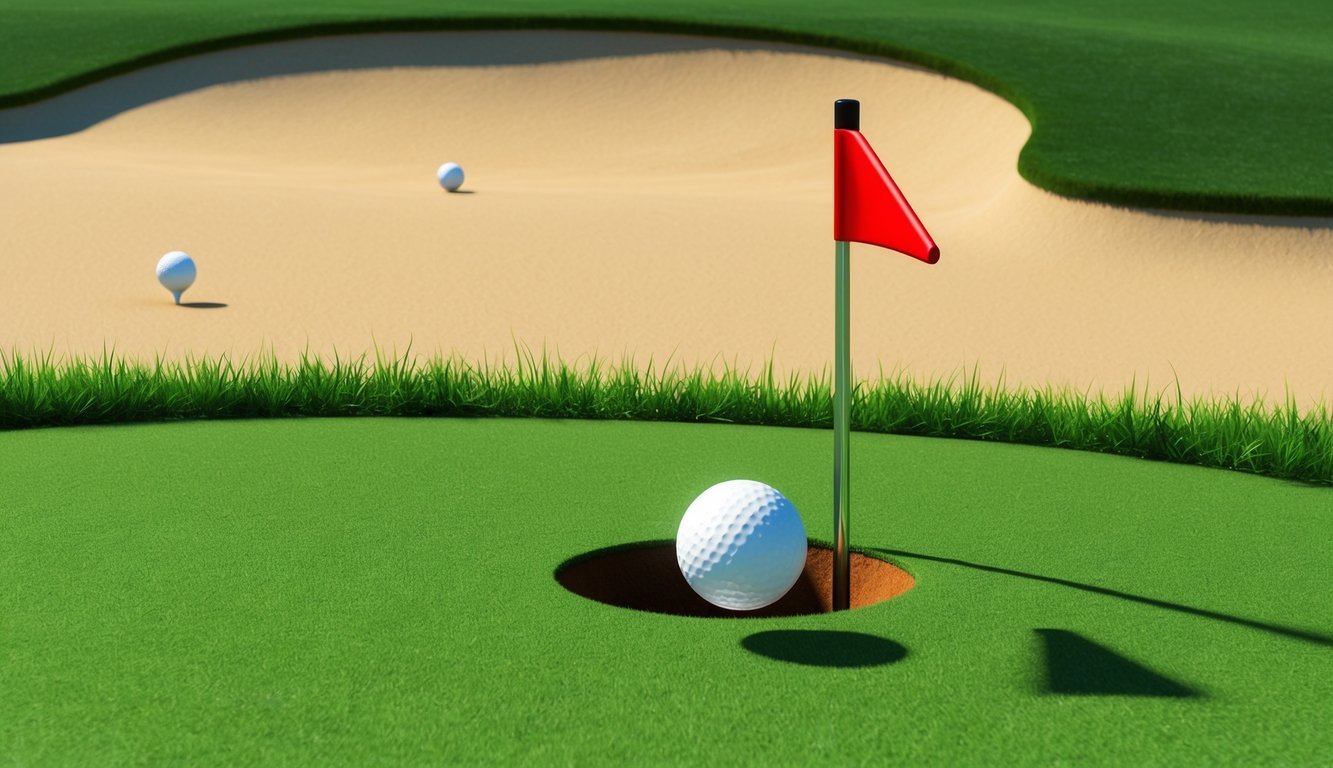In the game of golf, hitting the green in regulation, or GIR, stands as a crucial marker of success.
It involves reaching the green in two strokes less than the par for that hole. Achieving a higher GIR percentage can significantly enhance your performance by making pars and birdies more attainable. But why is GIR so important, and how can you boost your stats?

Understanding what affects your GIR percentage can be enlightening.
Factors such as ball striking, course management, and the choices you make on the greens all impact this important golf statistic.
By focusing on these areas, you can start shaving strokes off your game and enjoy a more consistent performance on the course.
Improving your short game also plays a vital role.
Golfers who excel in pitching, chipping, and putting often find it easier to convert their GIR opportunities into favorable scores.
As you analyze your GIR statistics, consider your unique skill level and how these insights could help in customizing your approach to the game.
Key Takeaways
- GIR boosts performance by increasing par and birdie chances.
- Focus on ball striking and course management to improve.
- Short game proficiency enhances GIR outcomes.
Understanding Greens in Regulation
Greens in Regulation (GIR) is a crucial golf statistic that impacts scoring and provides insight into your skills with approach shots.
By tracking GIR on your scorecard, you gain a clear picture of consistency and areas needing improvement, ultimately helping enhance your game.
Definition and Importance
Greens in Regulation measures your ability to reach the green on a golf hole in a predetermined number of strokes—specifically two strokes fewer than the par of a hole.
For example, a ball reaching the green in one shot on a par-3, two shots on a par-4, or three shots on a par-5 meets the GIR criteria.
Achieving GIR consistently can increase opportunities for birdies and lessen the risk of higher scores, as you avoid penalties and missed greens.
Understanding this concept helps analyze your approach shots and overall performance.
By aiming for a higher GIR percentage, you can identify specific aspects of your game needing attention.
Comparing your GIR stats to standards outlined by resources like GolfLink highlights differences between scratch golfers and higher-handicap players, guiding targeted practice.
Calculating GIR
Calculating GIR involves tallying the number of greens reached in regulation during an 18-hole round.
Each green hit according to the predetermined shots for its par counts towards your GIR statistic.
For instance, a green reached in two shots on a par-4 contributes to a positive GIR score.
Tracking this using your scorecard helps measure progress and pinpoint areas for improvement.
Focus on strategy to improve this stat.
Choosing the right club and perfecting your approach shot can significantly enhance your GIR percentage.
Additionally, evaluating conditions like wind and slope plays a role in achieving consistent results.
By concentrating on these factors, you’ll develop stronger skills and improve overall performance in the game of golf.
Improving Your GIR
Increasing your greens in regulation (GIR) involves focusing on effective club selection, mastering your tee shots, ensuring accuracy and aiming with precision, and maintaining consistent practice routines.
These aspects help align your approach shots and improve your overall golf game performance.
Effective Club Selection
Choosing the right club is essential to hitting greens more consistently.
Consider the distance to the green and any obstacles on the course when selecting a club.
Opt for a club that allows you to reach the green comfortably while also maintaining control over your swing.
Understanding your strengths helps in deciding whether to use a driver for distance or a more controlled iron for accuracy.
Test different clubs during practice sessions to see which ones give you the best results on varying course conditions.
Mastering the Tee Shot
Your tee shot sets the stage for reaching the green successfully.
Focus on achieving both distance and accuracy by choosing a stance that works for you and adjusting your swing accordingly.
A strong tee shot can position you favorably on the fairway, making your next shot less challenging.
Ensure your swing mechanics allow for maximum distance with minimal side spin.
Practice timing to achieve a clean hit, reducing the risk of veering off target.
A consistent rhythm in your swing is key to reliable tee shots.
Accuracy and Aiming Techniques
Improving accuracy involves honing your aiming techniques and shot placement.
Pay attention to wind direction and course layout as you determine your aim point.
Use visual markers on the course to help set your target more clearly.
Developing your pre-shot routine can enhance focus and consistency.
Concentrate on your grip and posture before executing the shot.
Practicing these techniques regularly helps in making successful shots towards the green more predictable.
Practice Routines and Techniques
Regular practice is crucial to improving your GIR.
Dedicate time to work on distance control and swing mechanics tailored to various greens.
Use drills that focus on aligning your clubface, correcting your swing path, and managing distances effectively.
Incorporate variety in your practice routines by alternating between long drives and shorter approach shots.
Simulate real-course scenarios to build adaptability and confidence on different greens.
Keep track of your improvements and adjust practice routines to tackle weaker areas in your game efficiently.
The Role of Short Game in GIR

Improving your short game is crucial for achieving more Greens in Regulation (GIR).
By refining techniques like chipping and putting, and employing smart strategies like course management, you can enhance your golfing performance.
These skills not only help you navigate various terrains but also improve your confidence on the green.
Chipping and Bunker Play
Chipping around the greens and mastering bunker shots can significantly impact your GIR.
The ability to execute an effective chip shot increases your chances of setting up easy putts.
It requires precision and control to land the ball close to the hole, which is vital for securing pars and birdies.
Bunker play, on the other hand, demands a specific set of skills.
You need to focus on positioning and power to successfully escape sand traps.
Understanding the texture of the sand and how it affects the ball’s movement is essential.
Practicing these shots regularly will boost your confidence when faced with challenging lies.
Shot Shaping and Course Management
Shot shaping involves altering the ball’s flight path to navigate the course effectively.
This is especially useful when dealing with obstacles like trees or strategic bunkers.
By learning to curve the ball intentionally, you can approach the green more successfully, improving your GIR.
Course management plays a critical role in guiding your decisions on the course.
By assessing factors like wind conditions and pin placement, you can choose the best shots to play.
This strategic planning will help minimize errors and maximize opportunities, enhancing your overall performance and GIR.
Putting and Distance Control
Putting is where the game can be won or lost.
By enhancing your touch on the putting surface, you reduce the likelihood of three-putting.
Consistent practice in controlling the ball’s speed helps improve your accuracy, lowering your scores in the process.
Distance control is another key aspect, especially for long putts or chips.
Being able to gauge the right amount of force required to reach the hole ensures better proximity.
This not only increases the chances of making the putt but also builds confidence, making it easier to tackle various putting challenges.
Analyzing GIR Statistics

When analyzing Greens in Regulation (GIR) statistics, you gain insights into a golfer’s consistency and approach performance.
By leveraging technology and data, examining professional tours, and learning from top players, you can enhance your understanding and improve your game.
Using Technology and Data
In the modern game, technology plays an essential role in analyzing GIR statistics.
Tools such as Arccos and other golf performance apps help track data points like shot distances and dispersion patterns.
By reviewing your data, you can identify trends and areas of improvement.
For instance, if you notice frequent misses to the left or right of greens, it indicates alignment or swing issues to address.
Statistical analysis can also reveal which clubs contribute to successful GIR, enabling you to focus on refining those aspects of your game.
Embracing these technologies allows for a more targeted approach to improving your performance on the course.
PGA and LPGA Tour Insights
The insights from the PGA and LPGA Tours can provide valuable benchmarks for amateur golfers.
The statistics from these tours highlight what separates elite players from the rest, offering a blueprint for aspiring golfers.
For example, players like Scottie Scheffler and Tiger Woods are known for their high GIR percentages due to their precision and distance control.
Examining tour leaders’ data can inspire you to adopt certain strategies or training routines.
By understanding what makes top golfers successful, such as focus on specific distances or improving second-shot accuracy, you can apply similar practices in your play.
Learning from Top Players
Top golfers provide a wealth of knowledge when examining GIR statistics.
Players such as Cameron Percy often share insights into their routines and thought processes on the course.
Observing these professionals reveals their emphasis on practice and mental preparation.
Utilize tips from top 100 teachers who guide pros on managing pressure and maintaining consistency.
Techniques taught by these experts, like precise alignment or managing ball flight, offer practical methods to enhance your golfing skills.
Incorporating these lessons from the best can lead to noticeable improvements in your own GIR statistics, ultimately lowering scores and increasing enjoyment of the game.
Catering to Different Skill Levels

Addressing Greens in Regulation (GIR) successfully can greatly enhance any golfer’s performance.
Adapting strategies based on skill levels, whether you’re an amateur or a low-handicapper, enables you to make the most of your abilities.
Fine-tuning your approach helps in improving consistency and unlocking birdie opportunities.
Advice for Amateurs and High-Handicappers
Amateurs and high-handicappers often struggle with hitting a significant number of greens in regulation.
To improve, focus on selecting clubs that inspire confidence, even if it means using a hybrid or wood instead of a long iron.
Practicing short game techniques is equally important, allowing you to recover when missing the greens.
Work on reading the course strategically to improve your scorecard performance, especially when you’re trying to break 80.
Understanding your limitations and setting achievable goals helps build consistency.
Remember, achieving a higher GIR percentage doesn’t come overnight.
Dedication to practice and learning from each round will progressively lower your handicap over time.
Strategies for Low Handicappers
Low handicappers often have solid GIR rates, as they focus on precision and strategic play.
To enhance your performance, refine approach shots to maximize birdie opportunities.
Utilize scoring clubs efficiently by concentrating on hitting precise distances and controlling the ball’s spin.
Consider tracking your GIR statistics over several rounds to identify patterns in your play.
Such insights can guide adjustments and help you maintain or even improve GIR percentages.
Experiment with different course management tactics, which can lead to the lowest possible scores.
With slight adjustments and focus, you can continue to excel and challenge your existing performance levels.

